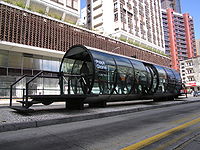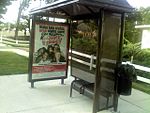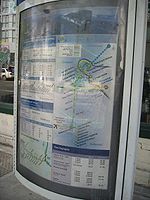- Bus stop
-
For other uses, see Bus stop (disambiguation).
 Bus shelter for the RIT system in Curitiba, Brasil
Bus shelter for the RIT system in Curitiba, Brasil
A bus stop is a designated place where buses stop for passengers to board or leave a bus. These are normally positioned on the highway and are distinct from off-highway facilities such as bus stations. The construction of bus stops tends to reflect the level of usage. Stops at busy locations may have shelters, seating and possibly electronic passenger information systems; less busy stops may use a simple pole and flag to mark the location and 'customary stops' have no specific infrastructure being known by their description. Bus stops may be clustered together into transport hubs allowing interchange between routes from nearby stops and with other public transport modes.
For operational purposes there are three main kinds of stops: Scheduled stops, at which the bus should stop irrespective of demand; request stops (or flag stop) where the vehicle will only stop on requested and hail and ride stops where a vehicle will stop anywhere along the designated section of road on request. Certain stops may be restricted to 'set-down only' or 'pick-up only'. Some stops may be designated as 'timing points' and if the vehicle is ahead of schedule it will wait to ensure correct running to the timetable. In dense urban areas where bus volumes are high, skip-stops are sometimes used to increase efficiency and reduce delays at bus stops. Fare stages may also be defined by the location of certain stops in distance or zone based fare collection systems.
Contents
Construction
Bus stops infrastructure ranges from a simple pole and sign, to a rudimentary shelter, to sophisticated structures. The usual minimum is a pole mounted flag with suitable name/symbol. Bus stop shelters may have a full or partial roof, supported by a two, three or four sided construction. Modern stops are mere steel and glass/perspex constructions, although in other places, such as rural Britain, stops may be wooden or brick built. The construction may include small inbuilt seats. The construction may feature advertising, from simple posters, to complex illuminated, changeable or animated displays. Some installations have also included interactive advertising. Design and construction may be uniform to reflect a large corporate or local authority provider, or installations may be more personal or distinctive where a small local authority such as a parish council is responsible for the stop. The stop may include separate street furniture such as a bench, lighting and a garbage receptacle.
Individual bus stops may simply be placed on the sidewalk next to the roadway, although they can also be placed to facilitate use of a busway. More complex installations can include construction of a bus turnout or a bus bulb, for traffic management reasons, although use of a bus lane can make these unnecessary. Several bus stops may be grouped together to facilitate easy transfer between routes. These may be arranged in a simple row along the street, or in parallel or diagonal rows of multiple stops. Groups of bus stops may be integral to Transportation hubs. With extra facilities such as a waiting room or ticket office, outside groupings of bus stops can be classed as a rudimentary bus station.
Convention is usually for the bus to draw level with the 'flag', although in areas of mixed front and rear entrance buses, such as London, a head stop, and more rarely a tail stop, indicates to the driver whether they should stop the bus with either the rear platform or the drivers cab level with the flag.[1]
In certain areas, the area of road next the bus stop may be specially marked, and protected in law. Often, car drivers can be unaware of the legal implications of stopping or parking in a bus-stop.[2]
In bus rapid transit systems, bus stops may be more elaborate than street bus stops, and can be termed 'stations' to reflect this difference. These may have enclosed areas to allow off-bus fare collection for rapid boarding, and be spaced further apart like tram stops. Bus stops on a bus rapid transit line may also have a more complex construction allowing level boarding platforms, and doors separating the enclosure from the bus until ready to board.
Information
See also: Public transport timetablePublic facing information
Most bus stops are identified with a metal sign attached to a pole or light standard. Some stops are plastic strips strapped on to poles and others involve a sign attached to a bus shelter. The signs are often identified with a picture of a bus and/or with the words bus stop (in English speaking countries).
The bus stop flag will sometimes contain the route numbers of all the buses calling at the stop, optionally indicating frequent, infrequent, 24 hour and night services. The flag may also show the logo of the dominant bus operator, or the logo of a local transit authority with responsibility for bus services in the area.Additional information may include an unambiguous name for the stop, and the direction/common destination of most calling routes. Bus stops will often include timetable information, either the full timetable, or for busier routes, the times or frequency that a bus will call at the specific stop. Route maps and tariff information may also be provided, and telephone numbers to relevant travel information services. The stop may also incorporate, or have nearby, real time information displays with the arrival times of the next buses. Increasingly, mobile phone technology is being referenced on more remote stops, allowing the next bus times to be sent to a passenger's handset based on the stop location and the real time information. Automated ticket machines may be provided at busy stops.
The data model
Modern Passenger information systems and journey planners require a detailed digital representation of the stops and Transportation hubs. The CEN Transmodel data model, and the related IFOPT data interchange standard, defines how transport transport systems, including bus stops should be described for use in computer models. In Transmodel a single bus stop is modelled as a 'Stop Point' and a grouping of nearby bus stops as a Stop Area or Stop Place. The General Transit Feed Specification standard, which was developed by Google defined a simple by widely used data interchange standard for public transport schedules which includes a table of Stop points which gives a name, identified and location for each bus stop. OpenStreetMap has a modeling standard for bus stops.[3]
The United Kingdom has collected a complete database of its public transport access points, including bus stops, into the National Public Transport Access Nodes (NaPTAN) database with details of 350,000 nodes and which is available as open Data from data.gov.uk.[4]
Safety
Bus stops enhance passenger safety in a number of ways:-
- Bus stops prevent passengers trying to board or alight in hazardous situations such as intersections, or where bus is turning and is not using the curb lane.
- A bus driver cannot be expected to keep a look out for intending passengers for the whole of the journey. A bus stop means that the driver only needs looking out at the approach of each bus stop.
- Having bus stops rather than a free for all means the passenger group themselves when boarding, which reduces time spent at boarding.
- At night, when passenger numbers are low, set down restrictions are sometimes relaxed and passengers may be set down anywhere within reason.
- Bus bays allow buses to arrive at a stop, but it does not impede the flow of traffic on the roadway
Research
A number of research efforts have concluded that the optimal bus stop spacing for most transit routes is somewhere between 1000–2000 feet (300-600m).[citation needed] Many transit agencies have developed guidelines for preferred bus stop spacing. In most U.S. cities, however, the typical bus stop spacing is between 650 and 900 feet (200–275 m), well below the optimal.[citation needed]
Bus stop vehicle capacity is often an important consideration in the planning of bus stops serving multiple routes within urban centers. Limited capacity may mean buses queue up behind each other at the bus stop, which can cause traffic blockages or delays. Bus stop capacity is typically measured in terms of buses/hour that can reliably use the bus stop. The main factors that affect bus stop capacity are:
- Number of loading areas (or number of buses that can stop at one time)
- Average Dwell Time (How much time it takes a bus to load/unload passengers)
- G/C ratio of nearby traffic signal (green time / cycle length)
- Clearance Time (time it takes bus to re-enter the traffic stream)
Detailed procedures for calculating bus stop capacity and bus lane capacity using skip stops are outlined in Part 4 of the Transit Capacity and Quality of Service Manual, published by the US Transportation Research Board.
Transit agencies are increasingly looking at consolidation of possibly previously haphazardly placed bus stops as a way to improve service cheaply and easily. Bus stop consolidation evaluates the bus stops along an established bus route and develops a new pattern for optimal bus stop placement. Bus stop consolidation has been proven to improve operating efficiency and ridership on bus routes.
Fake bus stops
Nursing homes have built fake, imitation bus stops for their patients who are suffering from dementia. Some of these bus stops are even fitted with outdated advertisements and timetables – 30 years outdated. The patients will sit at the bus stop waiting for a bus to take them to their imagined destination. After some time the nursing staff comes to escort the clients back to the retirement home.[5]
Dwell time
Dwell time is the scheduled time a bus is allowed to discharge and take on passengers at a stop, including opening and closing doors.
Legislative controls
Some jurisdictions have introduced particularised legislative controls to foster safer bus stop design and management. The State of Victoria, Australia, for example, has enacted a Bus Safety Act which contains performance-based duties of care[6] which apply to all industry participants who are in a position to influence the safety of bus operations - what is called the 'chain of responsibility'. The safety duties apply to all bus services, both commercial and non-commercial, and to all buses regardless of seating capacity. Breach of the duty is a serious criminal offence which carries a heavy penalty.
The primary duty holder under the Bus Safety Act is the operator of the bus service, as the person who has effective responsibility and control over the whole operation.[7] However, the Act also contains a safety duty covering people with responsibility for bus stops including people who design, build or maintain the stop and who decide on its location.[8]
This duty was introduced in response to research showing that the most serious hazard associated with bus travel occurs when passengers, especially children, are crossing the road after alighting from the bus. The location and layout of a bus stop is therefore a factor in the level of risk.[9]
Safety duties are also imposed by the Bus Safety Act on a range of other people including -
- bus safety workers including drivers, schedulers who set bus timetables, and mechanics and testers who repair or assess vehicle safety[10]
- procurers - that is, people who procure the bus service, known as the customer in the commercial charter sector.[11]
All of these persons can clearly affect bus safety. They are required by the Bus Safety Act to ensure that, in carrying out their activities, they eliminate risks to health and safety if 'practicable' - or work to reduce those risks 'so far as is reasonably practicable'. This familiar practicability formula is borrowed from Victoria's Rail Safety Act (and a subsequent national model Rail Safety Bill) and the Occupational Health and Safety Act 2004.
In popular culture
 A Jewish bus stop in Kiryas Joel, New York
A Jewish bus stop in Kiryas Joel, New York
Bus stops are common tropes in popular culture. In 1956 there was a Marilyn Monroe film called Bus Stop. A famous scene in the movie Forrest Gump takes place at a bus stop.
In Japanese culture, the movie My Neighbor Totoro featured a bus stop, both for ordinary buses and a cat bus. The opening scene of the anime Air shows the main character getting off at a bus stop. The Japanese movie Summer Wars features a rural bus stop.
Bus stops in Jewish culture
The following stories shed light on how renowned rabbis taught lessons in Judaism from their interaction and experience with bus stops.
Bishvili nivro ha-olom
The Brisker Rov used to walk with Reb Rephoel from his house on Rechov Press to the bus stop on Rechov Haneveim and take the number nine bus to Mount Scopus. Once, when they walked to the bus stop, they saw that the bus stop had been moved approximately one hundred meters. The Brisker Rov asked his son: "Rephoel, why have they moved the bus stop? Reb Rephoel, who always had an understanding of such matters, explained the change in terms of the traffic patterns. The Brisker Rov said to him: “No, Rephoel, you are not thinking as one should. A person has to think bishvili nivro ha-olom (The world was created for me.) They moved the bus stop because it seems that I have to walk another one hundred meters.[12]
Uvelechtacho Baderech
The students of Kol Torah yeshiva were accustomed to greet their teacher Rabbi Shlomo Zalman Auerbach on his arrival at the bus stop near the yeshiva. On the way to the yeshiva, they would ask him questions. After the lecture, they would accompany him back to the bus stop, discussing Torah with him the entire time.[13]
Waiting for the bus
Rabbi Elya Lopian studied at the Kelm Talmud Torah in his youth. He was known for his strict orderliness and strong sense of self-control. It is told that he wouldn't turn his head without a reason and a structured decision. He was once waiting at a bus stop and momentarily glanced up to see if the bus was coming. Immediately he regretted his action and chastised himself. He exclaimed "Had I been in Kelm, I would have gotten an hour mussar shmuze (Jewish ethics and self-improvement lecture)"." Lopian was remorseful for having allowed his emotions to rule over his mind. He felt that his action was futile as it had not caused the bus to arrive any quicker.[14][15][16]
Rabbi Dessler
Kelm emphasized an honest searching within one’s self and a rigorous avoidance on any action that might be in any way questionable. Rabbi Eliyahu Eliezer Dessler was once waiting at a bus stop in a driving rain when a former student drove by in a van. He stopped and offered Rabbi Dessler a ride. But before he would get in, Rabbi Dessler asked who owned the van and whether he had permission to pick up passengers.
On another occasion, he escorted Rabbi Shlomo Wolbe out of his house under the premise that he too had to go out so that the younger mashgiach would not be embarrassed to have Rabbi Dessler accompanying him. Rabbi Dessler did not specify his destination and walked alongside Rabbi Wolbe to the bus stop, where he remained until his visitor’s bus arrived.[17]
Gallery
-
Colorful "windmill" shelter at bus stop in Jalasjärvi, Finland
-
Transport for London bus stop signage in Oxford Street, London, UK
-
A modern column shaped bus stop in Venlo, Netherlands
See also
- Automatic vehicle location
- Bus bulb
- Bus Safety Act
- Bus station
- Bus terminus
References
- ^ London Transport historical bus stop signs
- ^ Nottingham city transport Bus Lanes and Bus Stops - what's the problem?
- ^ "Bus Stop". OpenStreetMap. http://wiki.openstreetmap.org/wiki/Bus_stop. Retrieved 2010-03-25.
- ^ "National Public Transport Access Nodes (NaPTAN)". data.gov.uk. http://data.gov.uk/node/8473.
- ^ Bus-Stops at Old People's Homes Take Patients for a Ride DW-WORLD.DE Retrieved on June 8, 2008
- ^ Bus Safety Act 2009, Part 3.
- ^ Bus Safety Act 2009, section 15.
- ^ Bus Safety Act 2009, section 18.
- ^ See Improving Bus Safety in Victoria, a discussion paper published by the Department of Transport in May 2009.
- ^ Bus Safety Act 2009, section 17.
- ^ Bus Safety Act 2009, section 16.
- ^ B. C. Glaberson (1 June 1999). The life and times of Reb Rephoel Soloveitchik of Brisk. Feldheim. p. 96. ISBN 9781583303610. http://books.google.com/books?id=svMRAQAAIAAJ. Retrieved 10 October 2010.
- ^ Rav Shlomo Zalman Auerbach, Yated Neeman
- ^ Nisson Wolpin (2002). Torah leaders: a treasury of biographical sketches collected from the pages of the Jewish Observer. Mesorah Publications in conjunction with Agudath Israel of America. p. 243. ISBN 9781578197736. http://books.google.com/books?id=qZkRAQAAIAAJ. Retrieved 6 October 2010.
- ^ A. L. Scheinbaum (February 1998). Peninim on the Torah. Peninim Publications in conjunction with "The Living Memorial," a project of the Hebrew Academy of Cleveland. p. 138. ISBN 9780963512062. http://books.google.com/books?id=C_MgusQWDnUC. Retrieved 10 October 2010.
- ^ Yonason Rosenblum (2000). Rav Dessler: the life and impact of Rabbi Eliyahu Eliezer Dessler the Michtav m'Eliyahu. Mesorah. p. 66. ISBN 9781578195060. http://books.google.com/books?id=pH4RAQAAIAAJ. Retrieved 10 October 2010.
- ^ The Power of his example
External links
Categories:- Bus transport
- Bus stations
- Street furniture
Wikimedia Foundation. 2010.









